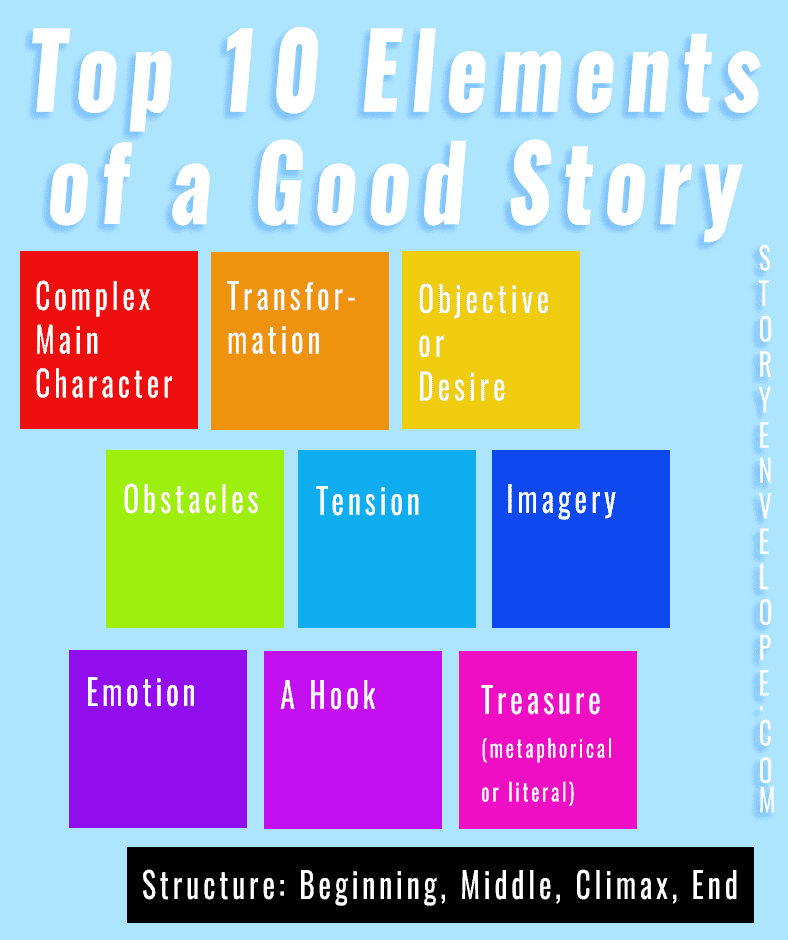7 Elements of a Story: The Recipe for a Great Narrative
“Storytelling is the most powerful way to put ideas into the world.”– Robert McKee, professor
Whether a non-fiction writer, casual writer, or creative writer, you must constantly hone your writing skills. It requires a lot of practice and keenness. In a competitive market, book writing services and publishers emphasize that writers should know the art of storytelling and the purpose of narrative writing. A well-structured and eye-catching narrative attracts publishers and editors and has a high market value. Today, more customers are enticed by the magnificent and impressive story, tempting theme, and book cover designs that hook their attention. When readers see an appealing story, they are motivated to pick it up and look closer to reading it. As an author, you must focus on creating immersive content that instantly prompts readers to buy the book. Therefore, this emphasizes book writing services professionals to develop an understanding of key elements that help to create a fascinating narrative. Once you master narrative writing, you begin writing with a unique style, artistic expression, and creative writing on the topic that interests them. As a result, a book gains market value with a high vocabulary and knowledge. In addition, it opens readers’ minds to unique and creative ideas to create a captivating manuscript for the audience.
New and inexperienced writers may struggle to discover their voice for manuscript writing. They could not create an inspiring storyline and striking characters that form a core part of the narration. Moreover, they lack the research and knowledge skills to write to find relevant information regarding the topic of the book they aim to write. Consequently, many writers fail to enlist among top writers as they lack persistence and hard work. They fail to employ more effort in the early stages of writing, do little planning, are not focused, and have unrealistic expectations about writing their book. Hence, many writers quickly give up as they feel real trouble with their writing and do not move forward in completing their manuscripts.
Mastering the essential elements of a story
- Know your audience
Another element is to know the preference and interests of the audience. For instance, if they are writing a fiction story, they should be aware of the storyline and characterization that attract the audience. So they pick up those ideas for fiction writing. Similarly, if they are writing an essay could be useful for academic students. Finally, writing articles or blogs will be helpful for the wider population to gain knowledge. Consequently, knowing your audience can help you improve your tone and compose an appealing manuscript that instantly grabs the targeted audience’s attention.
- Identify the theme in the narrative
A successful book has a meaningful theme or has a story, message, or lesson to share with the readers. If the narrative is written without a purpose, it fails to inspire readers to choose the book for reading. On the other hand, a story without an inspiring theme remains unfocused and revolves around various random topics. Consequently, every story needs to have one central theme to create coherence. To make writing inspiring for readers, a writer should incorporate a strong and stimulating theme that allows an author to tackle complex ideas and multifaceted characterization. A clear, artistically composed theme will engage readers as it will stick in the readers’ minds until the end.
- Don’t ignore creative ideas that help to compose the plot
The thought of creating a thought-provoking and fascinating plot seems a daunting task for inexperienced writers. The best thing is to capture the ideas that pop up in the mind as writers begin writing. These creative ideas can be inscribed in a notepad or journal. These ideas may inspire a writer to craft an interesting and immersive plot. A compelling plot is the essential part of the story that creates a sequence of events comprising background information, conflict, climax, and the narrative’s conclusion. Some writers use the plot to map their stories during the initial writing process.
A plot progresses chronologically from an inciting incident, rising action to a climax. A dramatic plot with thrill and suspense leads to a sequence of cause-and-effect events and creates a whole chain of plots that formulate an exciting story. An engaging storyline describes the characters, their role in the novel, and their essential attributes. In addition, readers are introduced to the main players and other characters. Combining these elements provides a strong structure to the story.
- Characters in the narrative
Characters create your story. They are the life force of your story as different characters interact with one another, create conflict and drive the story forward. A narrative comprises main and secondary characters that form a core part of a writer’s narrative process. Each character has their own story. The leading character is the personality that the novel revolves around. The main characters are the hero and the heroin, who lead various story events. Secondary characters advance the main plot and subplots. Along with protagonist characters come antagonists. Different characterization develops a stronger connection within your story, creating suspense, excitement, and adventure that captivates the readers throughout the novel.
- Setting
The story’s setting allows the author to adapt something new to the story. It reflects the time, place, and environment in which the main characters operate. A creative setting implies a writer avoids writing lengthy and unexciting descriptions that may demotivate readers. Instead, merge short and interesting descriptions into different parts of the story that bring an immersive experience to the readers. Use five senses to describe each setting of your story.
The setting provides the framework for everything in a story and creates an alluring environmental setting that captivates readers. For instance, romance novels are typically set in small, cozy towns. At the same time, mystery and horror stories take place in isolated, frightening places such as a castle, a cabin in the woods, or a deep forest. As the examples demonstrate that every story requires a different setting, the author has to choose the narrative’s setting wisely. If a narrative has multiple settings, the author has to get involved with extensive research so that each setting gives a unique look and avoids overlapping. Once the characters in the story are formed, you need them to interact with the setting in specific and realistic ways. The characters’ relationships with the setting lead to strong character development.
- Conflict
In a story, the source of a conflict is either external or carried out by the antagonist or main character. The protagonist deals with the rising conflict by using suspense, adventure, and thrill that drive a story. The conflict builds tension in the plot that engages readers and tempts them to read each page with interest.
- Point of view
Your book writing point of view gives an impactful tone to the story. It all depends on how the writer has conceived the style and structure of his writing. For instance, some writers choose to write with a first-person narrator, while many prefer to adopt a neutral voice of a third-person narrator. First-person writing offers intimacy and builds relations between narrator and reader, while third-person narration offers the potential to create objectivity, awareness, and knowledge. A unique viewpoint will make the plot exciting; the author unfolds the central conflict, hence allowing readers to understand the motivation, meaning, and purpose behind writing the story.
- Style
The writing style combines the features that make the storytelling compelling for the audience. Everything from the pacing to tone, using specific words, phrases, and literary devices that refine the prose’s style. The author sets the narrative’s tone by using multiple writing diction involving exclusive word and grammar choices, theme, imagery, and symbolism. The writer uses literary devices such as metaphors, similes, and other figures of speech to capture imaginative scenes. Allegory uses characters and plots to depict abstract ideas and themes. In an allegorical story, things represent more than they appear to on the surface. In some narratives, An archetype brings familiarity and context to a story. It can be a character, a setting, a theme, or an action. Colloquialisms provide context to settings and characters and give an authentic look to the narrative. Hence, literary devices create impactful writing that exhibits the creative writing skills of a writer.
To Recapitulate
To become an eminent writer, you should continue to unleash your writing potential. You can be a world-class renowned novelist, an autobiography writer, or a best-seller writer by understanding how to employ the key narrative elements in your narrative. Young writers can gain proficiency in storytelling by creating a short story that focuses on one plot and one or two main characters with additional characters that build up the story. An inspiring theme, simple vocabulary, conflict, and climax in the story will help writers to create mesmerizing content for the audience.






